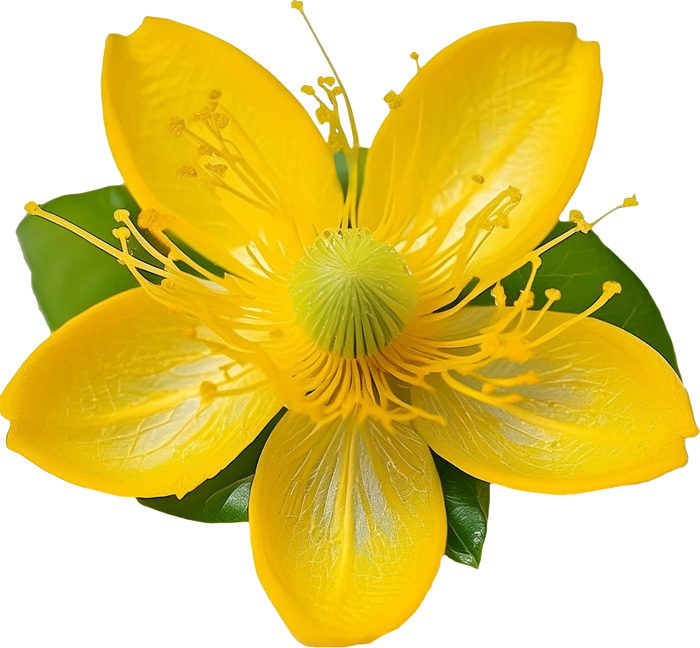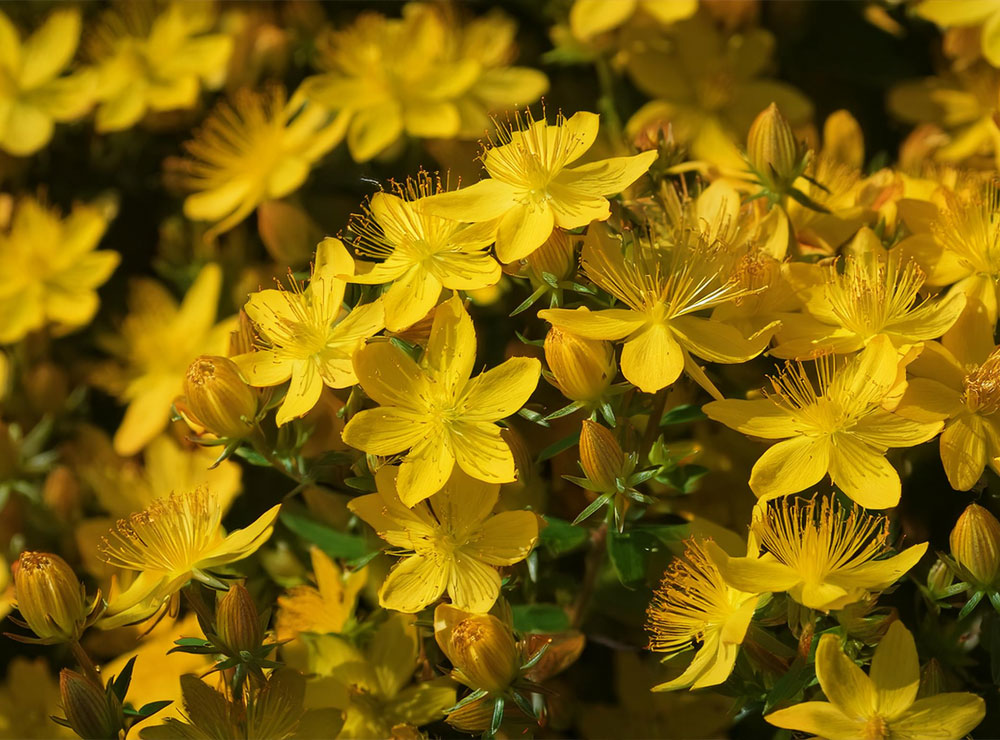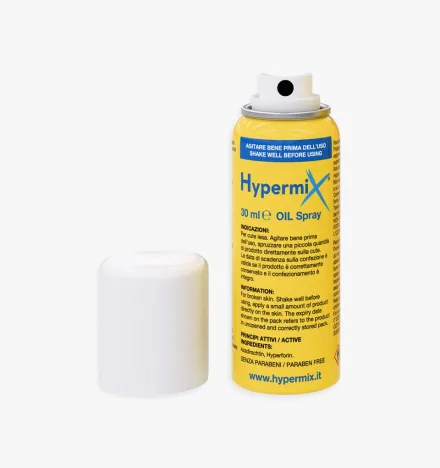Hypericum
A PLANT WITH MULTIPLE BENEFITS FOR MIND AND BODY
St. John's Wort, also known as St. John's Wort, is a golden-yellow medicinal plant that, in addition to being beneficial for humans, can also have positive effects on animals because of its calming, healing and anti-inflammatory properties.

NAME
Hypericum - Hypericum perforatum
FAMILY
Hypericaceae
WHERE IT IS USED
cosmetics, cooking, medicine
Hypericum plant and derivatives
PROPERTIES AND BENEFITS
Antiseptic
Fights skin infections due to its antibacterial properties.
Anti-inflammatory
Reduces inflammation in skin problems.

Healing and re-epithelializing
Accelerates healing of wounds, scrapes and injuries by supporting skin and tissue regeneration.
Soothing and calming
Reduces itching and redness, offering immediate relief in cases of insect bites or skin irritation.

Curiosities
The scientific name, Hypericum perforatum, delves further into the distinctive characteristics of the plant. "Hypericum" is derived from the Greek "hyper-eikon", alluding to a plant that grows over old statues, perhaps in reference to its ability to overpower other plants or landscape elements.
"Perforatum", on the other hand, describes the small transparent glands in the leaves, which look like tiny holes when viewed against the light, a detail that is not only fascinating but also helpful in identifying the authenticity of the plant.
Index
What is Hypericum: the plant
Hypericum, also known as "St. John's Wort," is a plant with origins in Europe, North Africa and West Asia, now widespread throughout the world. Its presence is common along roads, wooded glades and open meadows, environments that attract the attention of both nature lovers and animals, for whom this plant can have several benefits.
It is particularly prized for its pleasant fragrance and distinctive golden yellow flowers located at the end of stems that can reach a meter in height.
Botanically, Hypericum has an erect habit with stems branching at the top. The leaves are small, opposite and sessile, i.e., without a petiole, and have a very distinctive feature: numerous small translucent glands visible against the light, which give the leaves a speckled appearance of light.
Each flower of Hypericum consists of five petals that can have reddish hues. Commonly used parts of the plant include the buds, fresh flowers, and aerial parts harvested during flowering, up to the whole plant in bloom.
In veterinary phytotherapy, the parts used include the buds, fresh flowers and aerial parts harvested during flowering. These are known for their soothing, healing and regenerative properties, which are particularly useful for treating wounds, skin irritations and minor injuries in animals. In addition, Oleolite of Hypericum is often used to relieve muscle pain or promote skin recovery from abrasions or dermatitis.
Collection times
Harvesting of the flowering tops typically takes place in summer, between June and July, a time when the flowers are at the peak of their beauty, but not yet fully bloomed, to preserve their properties.
History of the Hypericum plant
Hypericum, or Hypericum perforatum, is a perennial herb that has fascinated mankind since ancient times. Known as "St. John's Wort" or "chastening herb," this plant has deep roots in the cultural and medicinal history of many societies.
The name "St. John's Wort," on the other hand, relates directly to the date of peak flowering, June 24, the day dedicated to St. John the Baptist. This time of year is historically significant for Hypericum, as its magical and healing properties were believed to be at their peak at this time.
During the Middle Ages, St. John's Wort was surrounded by an aura of mysticism and respect: knights had to swear before entering competitions that they had not hidden St. John's Wort under their armor. Superstition claimed that the plant could confer supernatural protections, making its use in battle dishonest.
The medicinal use of Hypericum is equally rich in history: traditionally, Oleolite of Hypericum was obtained by macerating the fresh flowering tops in vegetable oils. This remedy was particularly valued for its ability to promote skin regeneration and was also introduced into veterinary medicine to soothe wounds and skin irritations in horses, dogs, and other pets. This remedy was valued for its regenerative properties, useful for treating abrasions, bites, or minor traumas common in the lives of animals.
Properties
The main properties of Hypericum (for external use) useful for animals include:
- Anti-inflammatory
- Healing
- Regenerating
- Soothing
- Antiseptic
- Antiviral
- Antibacterial
- Analgesic
- Antispasmodic
Benefits for the skin and skin adnexa of animals
Oleolite of Hypericum, obtained by macerating fresh flowers in vegetable oil, is widely used to treat skin lesions and irritations in animals. Due to its dermo-repairing and regenerative properties, it is an effective remedy for relieving:
- Wounds
- Scratches
- Burns
- Plagues
- Hemorrhoids
Its anti-inflammatory and antiseptic properties make it ideal for preventing infection and accelerating wound healing. Hypericum promotes tissue regeneration and re-epithelialization, also proving useful for chronic injuries and fissures.
Muscle and joint support
In addition to its dermatological benefits, Hypericum is often used to relieve exertional muscle pain, contractures, and joint pain in animals, particularly horses and dogs. Its antispasmodic and pain-relieving effect also offers relief in hematoma and inflammation related to trauma or arthritis.
Natural protection for wounds, infections and skin health in animals
Due to its antiviral, antibacterial and antimicrobial properties, Hypericum is a natural option for managing skin infections and protecting the skin. Traditionally also used in farm animals, it is a versatile remedy to promote the well-being of various species.
You may not have known that…
In addition to its veterinary dermatological functions, Hypericum is also used as an antidepressant and to relieve symptoms related to mood swings in people.
Use
Hypericum has numerous applications in supporting animal health due to its anti-inflammatory, healing and regenerative properties. In particular, Hypericum Oil is used to treat a wide range of skin and muscle problems. Applied directly to the skin, it proves effective in promoting healing of wounds, abrasions, scratches, and light burns.
Its effectiveness is further enhanced in formulations such as Hypermix®, a plant-based product developed through advanced research, which combines the properties of Hypericum with those of Neem Oil. This synergy offers safe and effective treatment in a variety of situations:
- Acute or chronic injuries, including infected injuries
- Skin irritation and redness
- Small traumas, scratches and superficial wounds
- Dermatitis and insect bites
Hypermix® is a product that creates a protective barrier effect, promoting regeneration and repair of animal tissues. This makes it an ideal product for horses, dogs, cats and other exotic animals, contributing naturally to their well-being.
Contraindications
Despite the many therapeutic benefits of Hypericum, it is critical to consider the potential contraindications and risks associated with its use on animals.
In some cases, topical or internal use of Hypericum may cause:
- Redness or itching on the skin in individuals with sensitive skin.
- Localized skin eruptions in subjects allergic to Hypericum.
- Photosensitization, or increased sensitivity to the sun, which can lead to sunburn or skin lesions, especially in short-haired or fair-skinned animals exposed to direct sunlight or uvb rays during treatment.
Another important consideration concerns possible interactions with other topical treatments at the same application site, which may affect the efficacy of the product, which is why it is essential to consult a veterinarian before using it in combination with other therapies
In conclusion, Hypericum is a valuable resource in animal care, but its use should always be carefully evaluated and supervised by a veterinarian. With an informed approach, its benefits can be harnessed while minimizing the risks to animal welfare.
Products with Hypericum
St. John's Wort is one of the main components of the Hypermix® line dedicated to the diseases of our animals.
Subscribe to the Newsletter, for you 10% discount!
Stay up-to-date with all the latest news, promotions and exclusive offers from RI.MOS. VET.
Do you have a question?
Our team of experts has an answer for you!
What steps should be taken during the healing phase to prevent the animal from licking or damaging the wound?
During the healing phase of a wound, the animal may experience itching caused by normal healing. In such cases, specific devices such as Elizabethan collars, inflatable collars, breathable containment bandages, and braces can be used to avoid self-traumatization due to scratching, licking, and pecking.
What are the stages of wound healing?
There are three stages of wound healing:
Stage 1: exudative or inflammatory or also called cleansing stage
Stage 2: granulation or proliferative phase (granulation tissue formation)
Stage 3: epithelialization or regenerative phase (scar formation and epithelialization)




